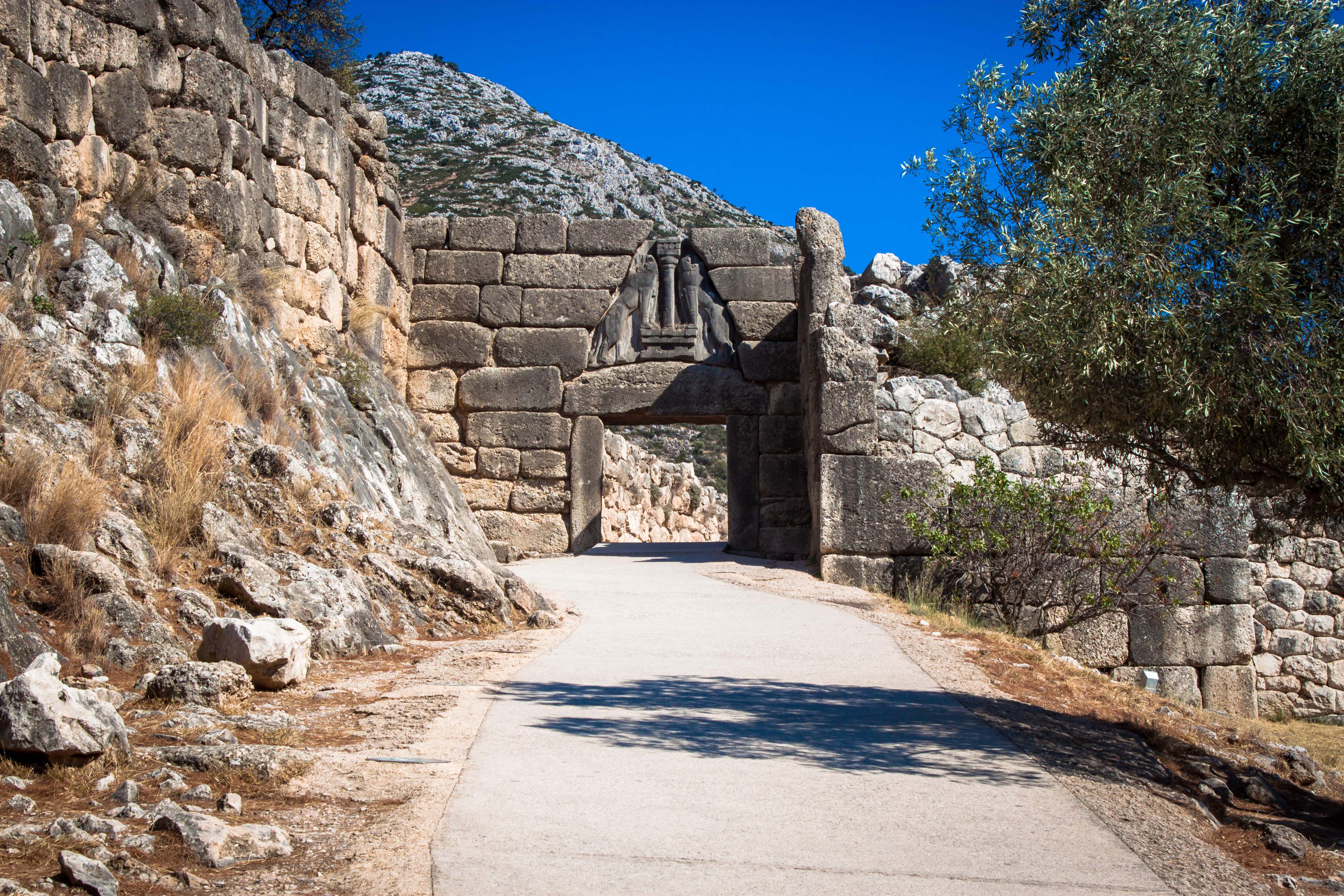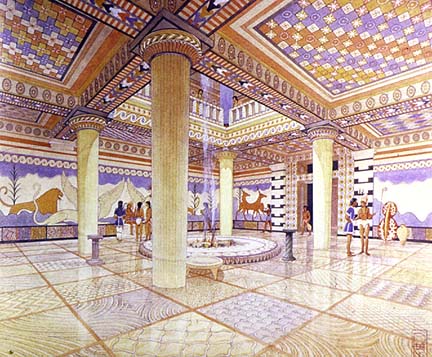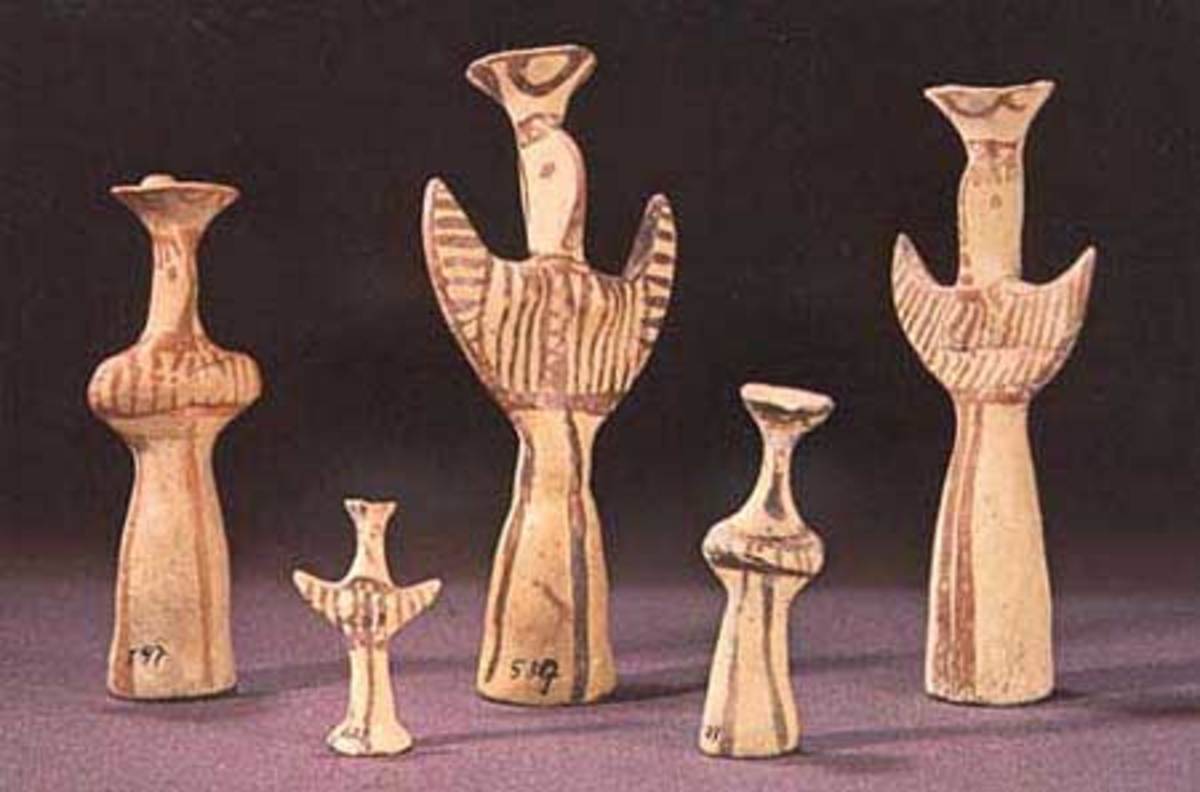
Mycenaean Palaces & the Bronze Age Collapse
Jun 10, 2024Moving forward in time from the early Shaft Tombs of Mycenae & Pylos, we reach the Late Helladic II period, which is a time that we know very little about archaeologically. To hearken back to my first episodes here, this is roughly the time where we start seeing Mycenaen culture & influence show up on Crete, but ironically we don’t really know what’s going on at Mycenae itself or in the wider Penopolese during this time. Nevertheless, around the beginning of the LBA III, around 1450 BCE we see the first Mycenaean palaces showing up. How these early palaces looked and were constructed, we don’t really know, and a lot of the remains we currently have date to later phases of construction, around 1300-1250 BCE.

While a few of these major palaces were known to us, Mycenae is actually generally not known for its palace, because the archaeological remains are heavily eroded. Realistically, we have an understanding of the walls, fortifications and some of the buildings there along with the Tholos Tombs, but the actual palace itself is heavily degraded and had a later Doric temple built over the top. A much better preserved example of a palace is Tiryns, in Argolis about 20km south of Mycenae, along with Pylos & Knossos, which became Mycenaean in its later periods.
The Homer Problem
This presents a problem for us when it comes to Homeric archaeology. If we cross reference the list of ships in the Iliad given by Homer, signalling all the kingdoms and people who took part in the Trojan War, this does not match a real life geography. Homer puts Nestor at Pylos, Agamemnon at Mycenae and mentions Lakonia and describes many of them as kings of city states or minor kingdoms. In reality, while some of the bigger areas like Pylos & Mycenae do seem to have a hinterland & state system, many of the places mentioned as kingdoms or palaces by Homer do not have such remains archaeologically. Lakonia for example, the area of later Classical Sparta, Homer tells us is supposed to have a palace and kingdom under Menelaus, but we haven’t found a good palace there during this time period.

The Menelaion (believed by classical-era Spartans to have been the burial place of Helen and Menelaos, and later a temple for their cults) doesn't date until the 8th century B.C, two centuries after the last Mycenaean palaces were sacked and burned. Despite pop cultural and historical fame, Homer is not a very good source to tell us what is going on archaeologically, for reasons I’ll discuss in the next episode.
The Structure of a Mycenaean Palace
So, let’s look at the Mycenaean palaces we DO have. These differ hugely from the earlier Minoan ones. Let’s look at Pylos, since it’s the best preserved.
The architectural layout is organised through a central axis, usually entering into a central court or chamber room which is more restricted. While there are no citadel walls, the palace sits on a hill. It consists of many rooms with a large square room in the centre known as a Megaron. In the centre of the Megaron there is a large circular decorated hearth and on the east side there is a space for a wooden throne. To the left of the entrance there are archive rooms, where many Linear B tablets have been found. There is also evidence of an upper floor and many rooms including pantries and large storage rooms.
The east side of the palace is thought to be more residential and has a smaller Megaron called the Queen’s Megaron, although much of the art and wall frescos surrounding it are battle scenes and have heavy warrior motifs, so this is questionable. So, what we can see here, in stark contrast to the Minoan palaces is a culture that has very defined notions of space, and especially one that centralises a Megaron and throne room, signally clear hierarchy at play. Looking to the textual sources, mainly the Linear B archives, they frequently speak of a Wanax & Wanas, conventionally translated as Lord and Lady, who likely sat in the throne room. The entire palace seems to be oriented around the central Megaron & throne room.

In terms of production and technical spaces, we see evidence of olive and wine presses, and possibly chariot workshops, but very little in the way of agricultural production. In contrast to the Minoan palaces which could have had communal feasting as their primary purpose, the Mycenaean ones do not have this objective. The Linear B tablets found at Pylos are most frequently found in areas associated with administration or craft production.
Outside of the main central axis areas of the palace are where we find the greatest evidence of artistry, mainly in the form of frescos. Similar to the earlier period iconography, it appears that the use of artistic motifs on the central processual way up to the throne room were designed to make an impression on visitors to the ruler, again acting as a symbol of cultural prestige. This theme seems fairly apparently in elite Mycenaean culture, where great effort is extended to elite architecture. While Crete was definitely interested in elite architecture, it wasn't really until the later periods. Since there are the remains of a Mycenaean wall around the Propylaea at the acropolis in Athens, it has been hypothesised that there is in fact a Mycenean palace under the Parthenon, that was destroyed and built upon over time.
While I mentioned them earlier, it is during this palatial period in the Late Helladic II that we find the other graves & tombs at Mycenae, known as the Tholos Tombs. These are outside the palace walls and fortifications, but incredibly spacious and well made, which is a clear statement of the kinds of people who were interred. So we can see a huge difference in cultures here between the Mycenaean and Minoan, where the Mycenaeans are differentiating social class very clearly, mainly through architecture. This theme seemingly goes back to the Shaft Grave Period mentioned in the last episode, which date to the same time as the pinnacle of Minoan culture on Crete, and are the dawn of Myceneaen culture, so potentially we are looking at two different cultures that express power & ideology very differently.
Linear B
One of the best ways to understand a culture’s ideology is through its written texts. For Mycenaean this is Linear B. I covered some theories about its development from Linear A on Crete in the last episode. It’s important to remember that despite the name, Linear A & B are different languages entirely. Linear A is not a known Indo European language, whereas Linear B is a very early form of Greek. The language is largely syllabic, with individual signs corresponding to syllables. It can however also be logographical, using signs that look like the thing they represent to codify it in writing, and this is often combined with syllabic writing systems. It is also common to write the number of items down on a tablet, so we have symbols for numbers. While this may sound romantic, in real life Linear B is often tedious to translate.

The vast majority of tablets are administrative in nature, simply cataloguing trade items, personal belongings and how stuff moved around from palace to palace. We can tell a lot about the economy & infer quantities of goods, and to a certain extent we know a bit about religion since texts frequently record which deities were worshipped or which offerings they received (and how much). We have no narratives, mythologies or stories in Linear B, only counting or administrative texts. This makes reconstructing the religion & practices difficult as the texts themselves only tell us who was offered what, or which titles certain deities had, many of which seem to be very different from their later Homeric & Classical roles.
Some notable examples that have caused much discussion in the past are that Hades does not appear in any known Mycenaean text, although Perseophne does, Dionysus appears frequently as a very important deity in terms of how many offerings go to him, but is absent from the later Homeric pantheon in place of Hestia, and Poseidon is frequently given the title of Wanax instead of Zeus, and for the most part seems to have had much heavier Chthonic associations along with two queens, known as the Wanassoi.

This older theology may in fact be preserved in the Eleusinian Mysteries & Persephone & Demeter’s Mystery Cult in Arcadia where her and Demeter are referred to as Despoinai (the two ladies). In the Arcadian cults, while Demeter was looking for the kidnapped Persephone, she caught the eye of Poseidon. She turned into a mare to escape him, but then he turned into a stallion to pursue her, eventually catching her and raping her. Afterwards, Demeter gave birth to the talking horse Arion and the goddess Despoina ("the mistress"), who was the primary goddess of the Arcadian mysteries, frequently said to be Persephone herself. In such a case, since Persephone appears to be older than Hades, and have underworld associations, the later Classical myth of her abduction may in fact be a fabrication in an attempt to explain her -then forgotten, presence in the underworld.
Trade with the Eastern & Central Mediterranean
Coming back to the archaeology, one of the other things that develops extensively during the Mycenaean Period is a huge degree of external trade. We see numerous Aegean cultural artefacts and motifs appearing throughout the wider Eastern Mediterranean, Cyprus, the Levant & Egypt. While these exchange networks began in the Minoan Period, evidenced by the Minoan frescoes at Tel el Daba in Egypt, during the Mycenaean Age, we see an explosion of trade. One of the most frequently traded items we see during this period are the famous stirrup jars.

These are high quality jars that are frequently closed or funnelled at the top, excellent for moving liquids such as wine or oil. Such oils, even during later periods, were considered valuable for medicinal use, and it appears that during this resurgence of trade, the Mycenaeans are pushing them for export. This is where something like the Uluburun Shipwreck has been a pivotal archaeological find.
Crashed off the south coast of Türkiye some time around 1250 BC, which was the height of the Mycenaean palatial period, this ship likely set sail from either a Cypriot or Syro-Palestinian port and contained luxury goods from numerous cultures, testifying to the massive regional networks that are compatible with today’s shipping. Some of the cargo included Cypriot copper, tin from Uzbekistan, Canaanite jars, Egyptian glass, blackwood logs from Africa, Baltic amber, a ceremonial axe made of green volcanic stone that originates from area Bulgaria & countless spices & foodstuffs. It is however worth noting that we don’t know whether the Uluburun ship was a luxury trade enterprise, being a one off, or if it was simply the standard for trade during the LBA.

Equally, the person or group organising this clearly had interconnected and powerful networks. Questions like who could afford all of this, especially since the ship was ultimately lost, are currently still being researched. Based on the corpus of writings from Tel Armana, known as the Armana Letters, we know that royal & elite families were involved in heavy trading at least between Egypt & the Levant.
So what we can see here is a continental trade network, mediated probably by the Mycenaeans that stretches from the Baltics in Eastern Europe to Sardinia and Italy in the West. A lot of the economic power is probably related to this new centralised network. The sheer interconnectivity of this network surpasses even the Minoan ones from the Early & Middle Bronze Age.
The LBA Collapse
Shortly after the date Uluburun however, we enter the most frightening and probably pivotal moment in the history of the Late Bronze Age, the Collapse.
This was a time of widespread societal collapse during the 12th century BC, between c. 1200 and 1150, associated with environmental change, mass migration, and the destruction and abandonment of cities. The Collapse affected a huge area of the Eastern Mediterranean and the Near East, particularly Egypt, Libya, the Balkans, the Aegean, Anatolia, and, to a lesser degree, the Caucasus. It was sudden, violent, and culturally disruptive for most of the Bronze Age civilizations, and brought a sharp economic decline to regional powers, ushering in the Greek Dark Ages across the Aegean.
The palace economies of the Mycenaeans, wider Aegean, and Anatolia that characterised the Late Bronze Age all disintegrated, transforming into the small isolated villages, which lasted from around 1100 to the beginning of the Archaic age around 750 BC. The Hittite Empire in Anatolia and the Levant collapsed, while states such as the Middle Assyrian Empire in Mesopotamia and the New Kingdom of Egypt survived but were hugely weakened. There is some destruction on Cyprus, but interestingly, for some reason it appears to bounce back much quicker and more strongly than surrounding regions, which will become crucial to understanding the next period of history, the Early Iron Age, as the Cypriots maintain contact with the central & eastern mediterranean.

It’s around this time that Egyptian pharaohs begin complaining about the mysterious Sea People. Many of them are even attributed names that are obviously Aegean or Sardinian. Contrary to popular belief however, people with similar names, depictions and ethnic background appear in Egyptian texts nearly 200 years prior to the LBA collapse, and only really become a problem during this time period. Such an appearance seemingly undermines the theory that the LBA Collapse was due to foreign invasions by such people.
In more modern scholarship, a model of internal economic collapse and usurpation has been proposed. Along with drastic climatic changes, the kings & elite of the Mycenaean palaces and wider Near East theoretically became too greedy and pushed their respective economies too hard. By pushing for constant elite goods to trade with each other, increased taxation and labour exerted a tremendous impact on artisan and craftwork classes of people, and without a rigid structure to constantly monitor local village economies, many such places began to develop and eventually undermine larger kingdoms.
With traders and artisans responsible for the means of production, and sailors responsible for ferrying things across the mediterranean, as soon as they realised that they can get better prices elsewhere, or perhaps even do their own thing since they are the ones who know the ports and primary trade routes, the high level palaces simply can’t compete. Coupled with civic unrest brought about by heavy taxes to support the bourgeois, which were producing little to no change in society except for the upper classes and elite, we potentially have people revolting and engaging in things that subvert the palatial & state economy.
This model has tremendous implications for how we interpret the Bronze Age Collapse. Is it really even a collapse at all?
Is it perhaps simply a refinement and transformation of the dominant economic and political model into more localised and subsidiary villages? Is it a move away from a highly hierarchical form of government and economy towards individual expression & personal ownership? This line of thinking may explain why smaller communities such as Cyprus and Italy actually survive and do well during the LBA Collapse, because they never participated in the palace economical system or had as heavily defined hierarchies.
Sources
Bouwman, A S; Brown, K A; Prag, J N.W.; Brown, T A. 2008: Kinship between burials from Grave Circle B at Mycenae revealed by ancient DNA typing. Journal of Archaeological Science. 35 (9): 2580–2584
Castleden, R. 2005: Mycenaeans. London and New York: Routledge.
Sherratt, E. S. 1990: Reading the texts: archaeology and the Homeric question, Antiquity 64, 807‑24
Bennet, J. 2013: Bronze Age Greece. In (Ed.), The Oxford Handbook of the State in the Ancient Near East and Mediterranean. Oxford University Press
Bennet, J. 1997: Homer and the Bronze Age, in I. Morris & B. Powell (eds.) A New Companion to Homer, 511‑34
Osborne, R.G. 1996 (or 2009 2nd ed.): Greece in the Making: 1200‑479 BC, Chapters 2 and 4‑5
Cline, E H. 2014: 1177 B.C.: The Year Civilization Collapsed. Princeton: Princeton University Press.
Bachhuber, C R. and Roberts, G. 2009: Forces of Transformation : The End of the Bronze Age in the Mediterranean : Proceedings of an International Symposium Held at St. John's College University of Oxford 25–6th March 2006 Paperback ed. Oxford
Oren, E D. 2000: The Sea Peoples and Their World : A Reassessment. Philadelphia: University Museum.
Steel, L. 2018: Watery Entanglements in the Cypriot Hinterland. Land. 7. 104. 10.3390
Spagnoli, F. 2015: Two Mycenaean Stirrup Jars From the Levant. Mediterranean Archaeology and Archaeometry, Vol. 16, No 1 pp. 185-192
William-Blegen, C. 2015: The Palace of Nestor at Pylos in Western Messenia, Vol. 1: The Buildings and Their Contents: Princeton Legacy Library, 1917
Vallence, J, R. 2015. A New Translation of KT FP 13
Champollion, F, J. 1832: Monuments de l'Egypte et de la Nubie: notices descriptives conformes aux manuscrits autographes rédigés sur les lieux.
Don't miss a post!
Sign up to get notified of when I upload as well as any new classes delivered to your inbox.
I hate SPAM. I will never sell your information, for any reason.

